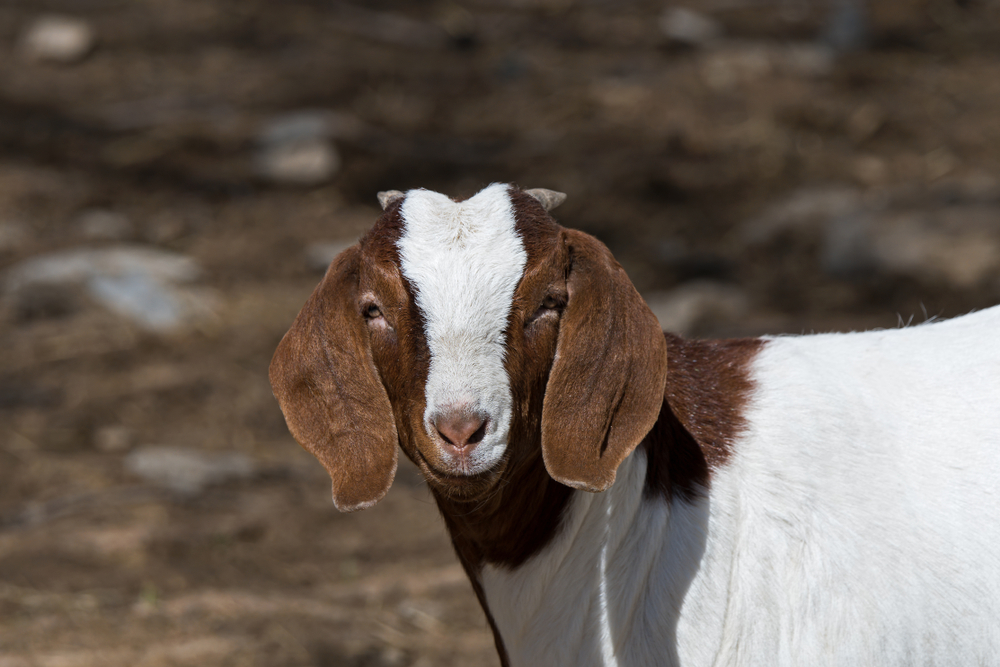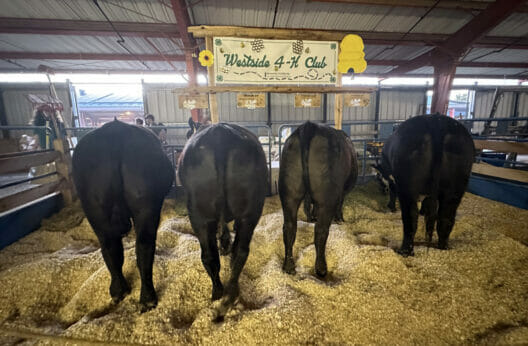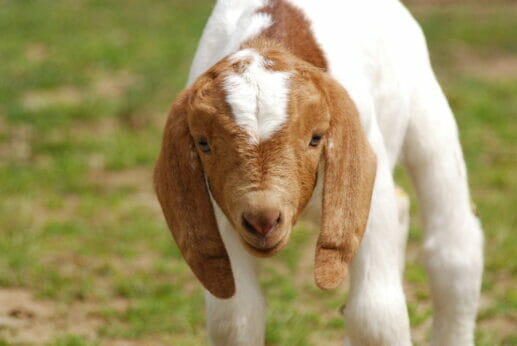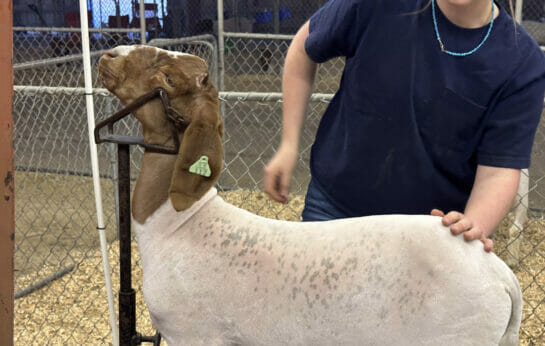4-H Goat Controversy Raises Questions About Kids and Terminal Livestock Sales
In the 4-H system, children as young as nine relinquish their animals for slaughter. Is it time the system changed?
4-H Goat Controversy Raises Questions About Kids and Terminal Livestock Sales
In the 4-H system, children as young as nine relinquish their animals for slaughter. Is it time the system changed?

4-Hers are encouraged to touch animals often and learn about their personalities.by Shutterstock.
One sweltering day last July, two Shasta County, Calif. sheriff’s deputies struck out on a 500-mile journey, armed with a search warrant. But this was no manhunt.
Law enforcement was hot on the trail of a 4-H goat.
Cedar, as his nine-year-old owner named the young Boer, had been whisked from the Shasta District Fairgrounds by the family to a distant farm after efforts to withdraw him from the auction were denied, prompting fair officials to send sheriffs to seize the alleged stolen property.
The girl and her mother had signed a contract with the fair, knowing the goat would be sold for its meat. It was the project she’d chosen in her 4-H club, a local branch of the U.S. Department of Agriculture’s nationwide youth development program. Still, she wept at the goat’s side when the bidding was over, asking that he not be killed. But the youth livestock rules governing these “terminal sales” defined only one off-ramp: the slaughterhouse.
“It’s really hard to get market animals off fairgrounds property once showing begins,” says Marji Beach, development director at Animal Place, a sanctuary in Grass Valley, Calif. where, every fair season, the requests roll in from children in 4-H and FFA (Future Farmers of America) who want to spare their pigs, cattle, goats and sheep.
A growing number are urban students who have nowhere to take their animal, even if allowed the option.
“On average, we receive around 40 requests a year,” says Beach, most involving market pigs. This fair season, it’s already reached capacity with the larger pigs. “Unfortunately, we can only say yes when we have space.”
The many projects of 4-H
4-Hers don’t have to choose a meat animal project. Fair participation isn’t even required. The nonprofit program, administered by state land-grant universities, offers more than 100 different “learn by doing” projects, with members enrolling in at least one each year.
Living on a farm is optional. Thousands of city slickers lease animals or raise creatures such as mice. On the non-meat menu is everything from tree planting, dance and public speaking to STEM (Science, Technology, Engineering and Math education). Animal projects include breeding, fiber, horse showmanship and more.
But 4-H, which is funded by the USDA, state and local governments, as well as corporate donors, is best known for its youth livestock program.
Market-animal projects produce significant, positive effects on 4-H enrollment, according to an analysis by the University of California Cooperative Extension.
The Shasta County fair website puts it this way: “The Junior Livestock Auction is the backbone to the Shasta District Fair as members from the superior Agriculture District 4-H and Future Farmers of America enter and show the animals.”
The top bidder receives meat from the animal, with the proceeds going to the child exhibitor and a small amount to the fair. More than 500 animals sold at the Shasta Fair in 2022 were then loaded onto trucks and hauled away for processing—as Cedar was slated to be.

At this point, the project is over. 4-Hers, depending on how well their club prepared them, have to imagine what happens next.
Adults might consider it fortunate that children don’t have to witness their animals’ slaughter or learn about the frequency of botched deaths, equipment malfunctions and violations of the USDA Humane Methods of Slaughter Act. According to a study by sociologists Leslie Irvine and Colter Ellis at the University of Colorado, 4-Hers “fully recognize this inevitable feature of the livestock project.”
Nevertheless, some students are horrified when they actually reach that goal on auction day.
Almost pets
A federal civil rights lawsuit filed by the family in Shasta County makes an unusual claim alongside its focus on the actions of officials. One argument of attorneys Ryan Gordon and Vanessa Shakib, co-founders of nonprofit Advancing Law for Animals, is that Cedar was seized because his owner “E.L.” expressed a non-agricultural view of him.
E.L. didn’t see “Cedes,” as she called him, as meat.
The 9-year-old had just reached the age allowed by state 4-H rules to pursue a large livestock project. It’s also an age far from decision-making maturity. Studies show cognitive capacity doesn’t reach adult levels until around age 16, and psychosocial maturity continues beyond 18.
Irvine and Colter, the sociology researchers, wanted to explore the so-called caring-killing paradox. Plenty of research has focused on the bonds between children and pets—but not when it comes to a living, bleating 4-H project. “Reproducing Dominion,” their 2010 paper, examines how children learn the belief that certain animals are created for human use, which the authors say is “the most important lesson conveyed in 4-H livestock programs.”
That lesson was no match for the three months E.L. spent raising an adorable baby goat, teaching him to walk on a leash and trust humans, to where he began rushing to greet her.
The researchers interviewed 4-Hers to study the emotional work learned from adult mentors and peers that teaches them to cope with conflicting feelings about their animals. On the path to becoming producers, students leaned on strategies such as not naming their market animals and reminding themselves that auctions help pay for college.

E.L., who was to receive almost $900 for her goat’s meat, just wanted Cedar back. That aligns with the study’s finding that auctions are harder for younger members aged 13 and under. Their empathy for their animals has all along been encouraged. Good care makes for good meat.
The 4-H literature instructs students to touch animals often, which prepares them for showing, and to learn all about their preferences and personalities.
All the touching, brushing and mapping of favorite scratch-spots and quirks is similar to that with a pet. And it occurs within a culture increasingly aware of animal emotions compared to when 4-H began more than a century ago.
The Humane Methods of Slaughter Act passed in 1958. Flash forward to 2015 when a Gallup poll found a third of Americans want animals to have the same rights as people. In a 2019 Gallup poll, nearly one in four were eating less meat. And, in 2023, the Supreme Court upheld California’s landmark farmed animal protection law.
In 4-H literature, the organization that began with a desire to modernize farming claims its message of youth development doesn’t change, “but the methods that drive the program forward often need to change with the times.”
Irvine says that these days it’s far less common for 4-Hers to be taking over the farm, needing to learn the realities of raising meat animals. In 2010, only 11 percent of 4-Hers lived on farms. So is the terminal auction essential?
“It does seem like it’s time for 4-H to change, both because of what we know about animals and because its members increasingly don’t come from agricultural backgrounds,” says Irvine.
“The contracts should also allow kids to change their minds, especially the younger ones.”
Rules are rules
It’s the fair that sets the auction rules, serving up contracts that 4-Hers and parents sign. Each county fair in California can make its own rules, so long as they don’t conflict with those of the state. 4-H has no oversight of fairs.
“County fairs and livestock auctions are learning experiences we prepare our members to participate in,” says Lynn Schmitt-McQuitty, Calif.’s Statewide 4-H director. The program’s volunteers and professionals work closely with youth in livestock projects, she says, helping them choose what best suits their goals—whether market, breeding or showmanship.
“Please know this incident does not reflect the values of the University of California 4-H youth development program,” she says of the fiasco over Cedar.

But strict rules for terminal sales are common around the country. The Shasta Fair’s rules allow for “no exceptions.” State rules prohibit live animal pick-up by buyers, except by the transportation provided by the fair to the slaughterhouse. How enforceable those rules are is now up for debate.
In January 2023, a Florida couple who won a pig they planned to rescue were told they could only have its meat. Why? The answers varied from state rules protecting animal enterprise to 4-Hers having raised the animals for the food chain.
Nor is Cedar’s case the first lawsuit ever filed after a student changed their mind.
Five years ago, songwriter Diane Warren won a lamb for a boy at an auction in Santa Barbara County. The fair refused to let it go home alive. Warren hired Advancing Law for Animals, which helped free the lamb.
The attorneys made an argument they are using again in the pending federal case, and it concerns a right minors can already exercise.
“This case preserves the legal status quo,” says Shakib. “Minors in California can disaffirm contracts, including contracts with 4-H.”
Children can break contracts because the law has long considered them incapable of fully understanding what they’ve signed.
Despite E.L.’s painful experience, she still wants to pursue animal husbandry education. If the attorneys prevail, local officials will acknowledge her right to opt out of any 4-H livestock auction she enters. While the state’s rules have seen revisions for 2023, including the recommendation of a pre-auction “intent to sell” list for children and parents to sign and clearer definitions of terminal and non-terminal auctions, there’s no mention of any such option.
In some states, there’s no need for it.
North Dakota fairs no longer hold kill auctions. In Minnesota, due to changing market demands and trends in consumer purchasing, there’s been a shift to premium auctions where animals are sold but typically go home with the student, who still receives most of the proceeds.
“I have been working with MN 4-H for a number of years and during that time I do not know of any required terminal shows,” Sharon Davis, University of Minnesota 4-H Extension director of animal science, said in an email. “4-H shows in Minnesota are non-terminal, allowing for youth to continue to learn and grow with their projects.”
The officials who had Cedar plucked from sanctuary and returned him to the fairgrounds to be slaughtered claimed to be bound by rules. Perhaps greater awareness of these other options, along with the wave of support for E.L.’s “non-agricultural” view of Cedar, will bring more choice to the rules around kill auctions.
Follow us

This work is licensed under a Creative Commons Attribution-NoDerivatives 4.0 International License.
Want to republish a Modern Farmer story?
We are happy for Modern Farmer stories to be shared, and encourage you to republish our articles for your audience. When doing so, we ask that you follow these guidelines:
Please credit us and our writers
For the author byline, please use “Author Name, Modern Farmer.” At the top of our stories, if on the web, please include this text and link: “This story was originally published by Modern Farmer.”
Please make sure to include a link back to either our home page or the article URL.
At the bottom of the story, please include the following text:
“Modern Farmer is a nonprofit initiative dedicated to raising awareness and catalyzing action at the intersection of food, agriculture, and society. Read more at <link>Modern Farmer</link>.”
Use our widget
We’d like to be able to track our stories, so we ask that if you republish our content, you do so using our widget (located on the left hand side of the article). The HTML code has a built-in tracker that tells us the data and domain where the story was published, as well as view counts.
Check the image requirements
It’s your responsibility to confirm you're licensed to republish images in our articles. Some images, such as those from commercial providers, don't allow their images to be republished without permission or payment. Copyright terms are generally listed in the image caption and attribution. You are welcome to omit our images or substitute with your own. Charts and interactive graphics follow the same rules.
Don’t change too much. Or, ask us first.
Articles must be republished in their entirety. It’s okay to change references to time (“today” to “yesterday”) or location (“Iowa City, IA” to “here”). But please keep everything else the same.
If you feel strongly that a more material edit needs to be made, get in touch with us at [email protected]. We’re happy to discuss it with the original author, but we must have prior approval for changes before publication.
Special cases
Extracts. You may run the first few lines or paragraphs of the article and then say: “Read the full article at Modern Farmer” with a link back to the original article.
Quotes. You may quote authors provided you include a link back to the article URL.
Translations. These require writer approval. To inquire about translation of a Modern Farmer article, contact us at [email protected]
Signed consent / copyright release forms. These are not required, provided you are following these guidelines.
Print. Articles can be republished in print under these same rules, with the exception that you do not need to include the links.
Tag us
When sharing the story on social media, please tag us using the following: - Twitter (@ModFarm) - Facebook (@ModernFarmerMedia) - Instagram (@modfarm)
Use our content respectfully
Modern Farmer is a nonprofit and as such we share our content for free and in good faith in order to reach new audiences. Respectfully,
No selling ads against our stories. It’s okay to put our stories on pages with ads.
Don’t republish our material wholesale, or automatically; you need to select stories to be republished individually.
You have no rights to sell, license, syndicate, or otherwise represent yourself as the authorized owner of our material to any third parties. This means that you cannot actively publish or submit our work for syndication to third party platforms or apps like Apple News or Google News. We understand that publishers cannot fully control when certain third parties automatically summarize or crawl content from publishers’ own sites.
Keep in touch
We want to hear from you if you love Modern Farmer content, have a collaboration idea, or anything else to share. As a nonprofit outlet, we work in service of our community and are always open to comments, feedback, and ideas. Contact us at [email protected].by Sheila Pell, Modern Farmer
June 27, 2023
Modern Farmer Weekly
Solutions Hub
Innovations, ideas and inspiration. Actionable solutions for a resilient food system.
ExploreExplore other topics
Share With Us
We want to hear from Modern Farmer readers who have thoughtful commentary, actionable solutions, or helpful ideas to share.
SubmitNecessary cookies are absolutely essential for the website to function properly. This category only includes cookies that ensures basic functionalities and security features of the website. These cookies do not store any personal information.
Any cookies that may not be particularly necessary for the website to function and are used specifically to collect user personal data via analytics, ads, other embedded contents are termed as non-necessary cookies.
Unless a child is a vegetarian or vegan, it is reasonable for 9 and older to learn where meat comes from by raising livestock for a 4-H auction. As the article says, a livestock for meat project is not required. They also have livestock breeding projects or lambs for wool etc. The situation with Cedar the goat was caused by a foolish parent that signed up for something she didn’t support. Either she was not thinking much or she was trying to sabotage the 4-h livestock project. An animal is property and subject to property laws. The girl may not… Read more »
What the parents of this 4H child taught her is, “go ahead and agree to something and if you change your mind we will help you break the rules and even ship the animal away and help conceal it.” Shame on them. They had a great opportunity to teach their child many good things through the child’s livestock project and they failed. The parents here are the problem. I was a 4H leader for years and never had parents teach such a bad lesson to their child like this. But I have had a number of heart felt talks with… Read more »
The 4H club and the child’s parents failed. I speak from experience as my own children raise market animals through 4H.
Prior to the sale, the animal should have been withdrawn, actually probably at the start of the project but definitely before the sale. The auction is a contractual agreement.
Really? There was a clear path here. The family KNEW what was going to happen. Someone PAID for that animal, the child and family got money, THEN THEY STOLE THE ANIMAL. THAT’S LIVESTOCK THEFT. Instead of whining about how they were trying to save that “poor” goat, they should be teaching her how we eat in this country, both vegetarians and meat eaters and it ALWAYS involves the death of something. Try doing some real reporting next time.
The parents taught the child the most important lesson we have to learn–to resist moral vulnerability. No matter what system you are in, no matter what your peers are doing, no matter what contracts have been signed, you can always back out and do the right thing. Listening to your conscience and saving a life is more important than going along with the crowd. She also learned how the strong arm of the law will go to great lengths to keep people in line, but compassion is more important. As a veterinarian, I always think of this article, and my… Read more »
The Family in question should have better informed themselves on the terms of the contract before signing it. That is one of the clearest things about all this. They also seem not to have understood the program the child was in. Another error on their part. On the other hand the folks running the fair seemed pretty determined to paint themselves as monsters or at least inept. The buyer wanted to give back the goat, this should not have been a problem. At any other fair except some 4H meat fairs if someone wants to withdraw an animal, buy an… Read more »
People need to realize that this is what 4h is all about teaching youth where their food comes from and what it takes to raise the animals. You have a choice to decide what you want to do, you are not forced to do it. We love our animals, our kids raise all kids. But, something that isn’t mentioned and kids need to understand. The BUYERS can choose to donate the animals back to the children, or let them go to local auctions to get some money back, or slaughter them for themselves to give to family, friends or employees.… Read more »
I was in 4H as a kid here in SD but before they started having the auctions of show animals. As a rancher myself I fully support these sales but most in my state have went to the Premium sale format where the kids retain ownership of the animal. The problem I see for areas where a substantial number of 4H’ers don’t live on a farm/ranch is a place to keep the animal if it isn’t slaughtered. Are you going to keep a 1200# steer in your backyard. Parents as well as the kids need to understand that keeping a… Read more »
I am surprised that the article did not mention the deaths in the little girl’s immediate family, that helped transition Cedar from a project to an emotional support animal. And I find it distasteful that if I purchase an animal at auction, that they 1) insist that the animal be killed, and 2) I won’t even get the meat of the animal that I purchased; that they can substitute in the meat of a far inferior animal. But I don’t eat mammal meat any more (alpha-gl allergy, something that totally happens on farms and ranches), but would consider purchasing animals… Read more »
Thank you, Shiela Pell, for this even-handed account of a good idea gone very wrong. It’s a shame Shasta County 4-H officials had nothing better to do than create a PR disaster for themselves while traumatizing a young girl in the process. At a time when small farms in the US are failing in droves, it’s astonishing that any 4-H program would go to such lengths to alienate young people who actually have an interest in participating in and perpetuating local agriculture. Equally bewildering are the comments here (from people who appear to be in the business themselves) defending the… Read more »